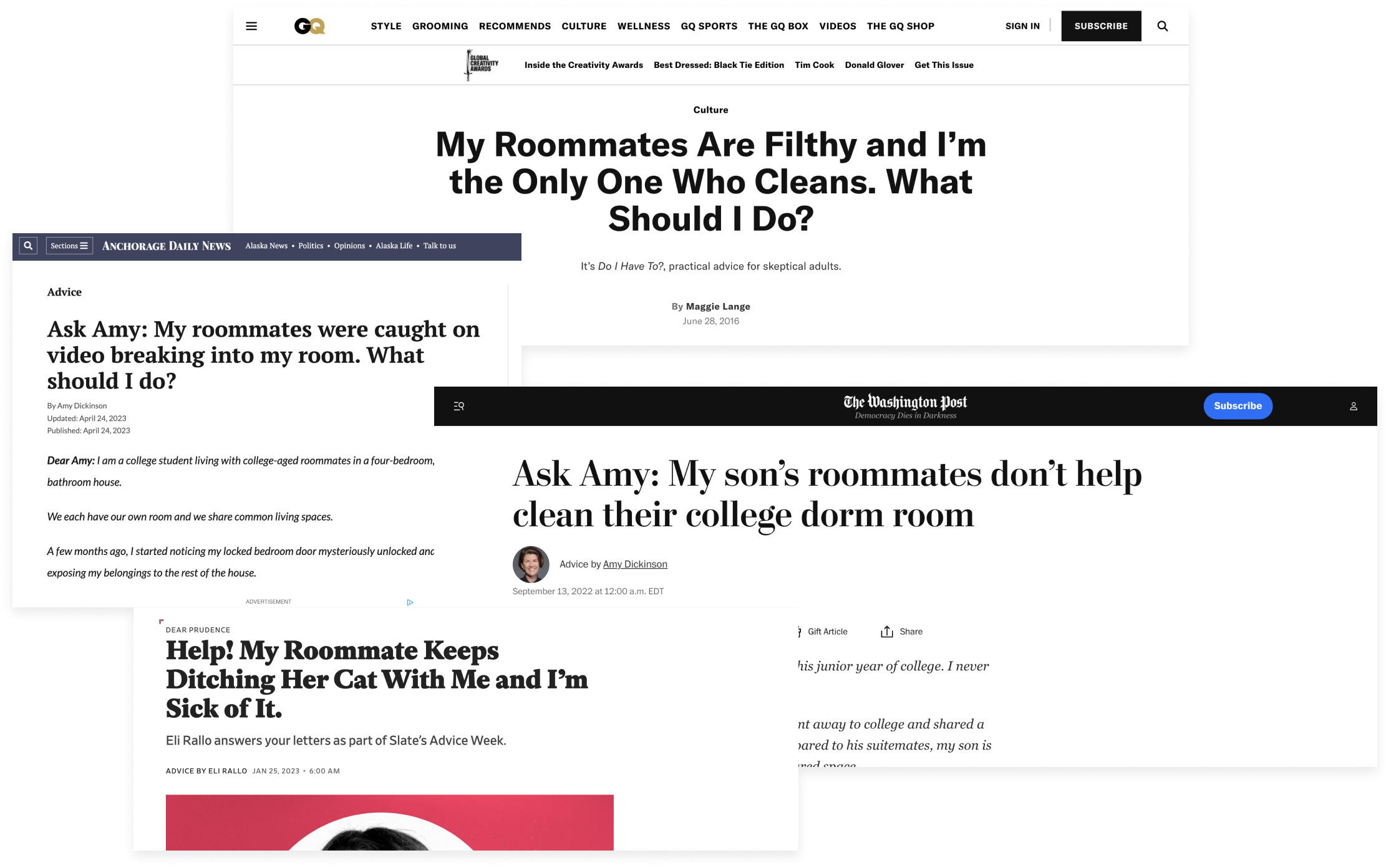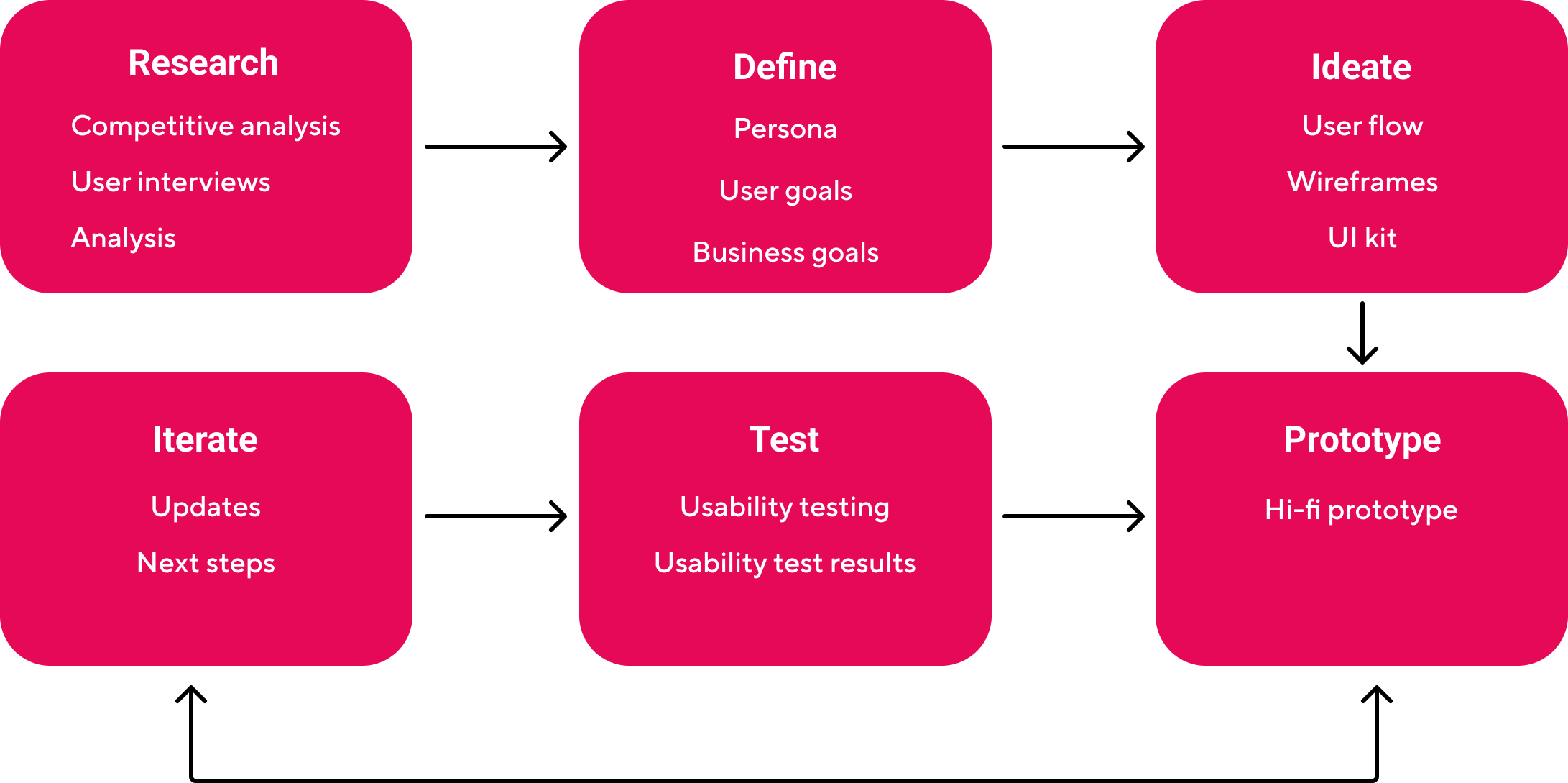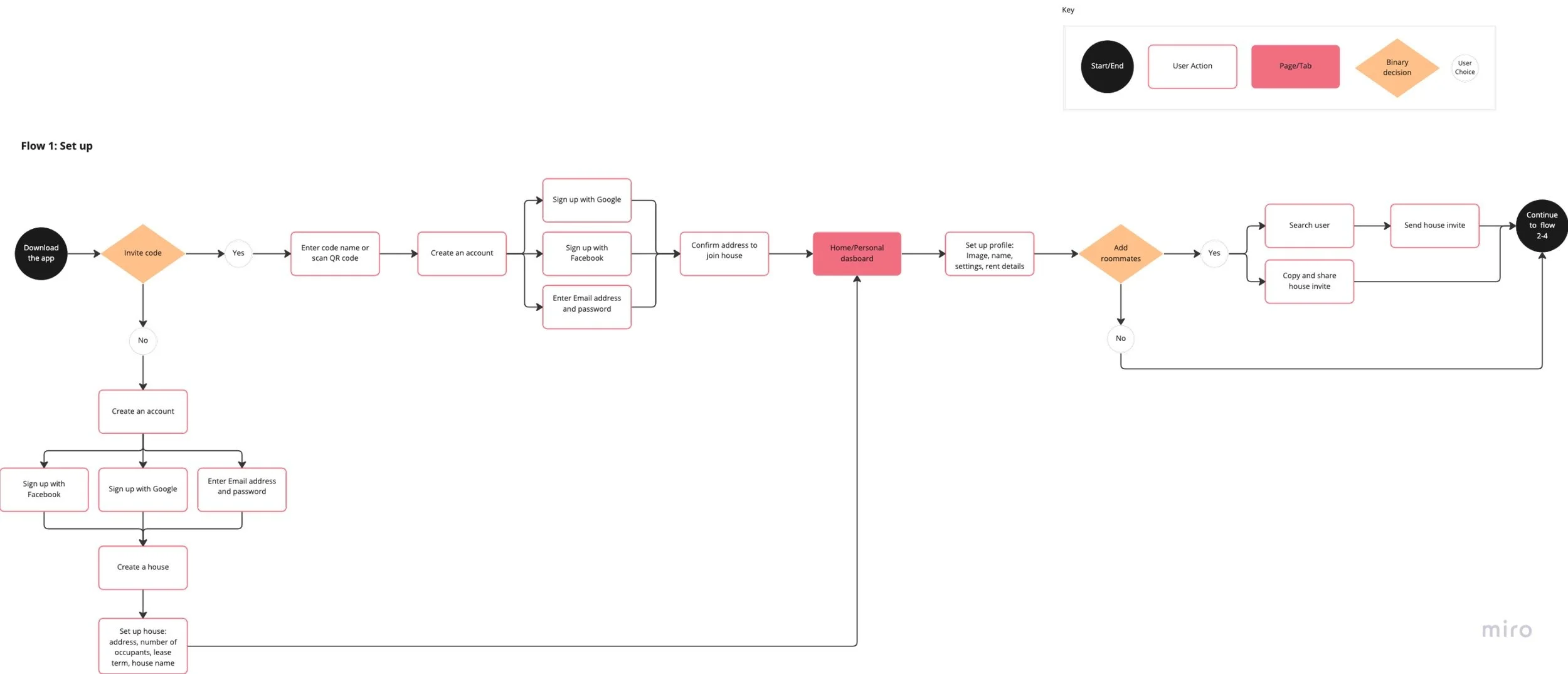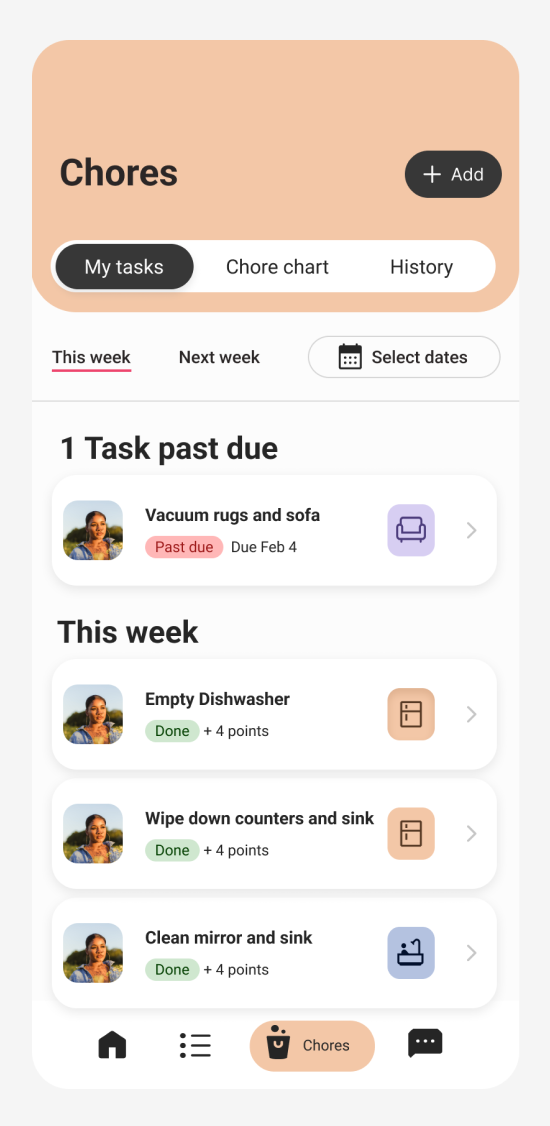Rumis household management app
An MVP mobile app design for adults living with roommates
Overview
According to Pew Research Center, more than 1 in 3 American adults share a household with another adult who is not their spouse. Living with a roommate can be a great way to save money but there may be challenges without proper communication (Who is responsible for the dishes piling up?) Ineffective communication can increase tension in the home and discourage feelings of security and peace.
Condense home management to one platform
Improve roommate communication
Create a design that requires the minimum effort from users
Organize tasks effectively
Targets
My role: User research, UX design, UI design
Platforms: iOS mobile app
Software tools:
Project management: Monday.com
Research: Calendly, Dovetail, Zoom
Design: Figma, Miro
Prototyping: Figma
Adults living with roommates need a new communication method because managing a household can be a challenge and may lead to avoidable conflicts. This project will explore how we might streamline roommate communication, promote shared accountability, and support users in household management.
Problem
Design thinking
Research
Rumis would not be the first app of its kind but many of the competitors focus on one area of household management like organizing and distributing chores or sharing finances. Two of the 4 direct competitors in this study have features that address multiple household management concerns. User research will validate the assumption that users want to improve communication in the areas of splitting costs, chores, and shared items.
Competitive analysis
We want to know how users currently manage to coexist with roommates and how they prioritize challenges.
User interviews
Understand users' current living situation
Identify user challenges and pain points
Differentiate high-priority communication from low-priority communication
Uncover differences in needs between target demographic groups (roommates, dating couples, parents living with adult children).
Determine how users identify successes
Objectives
User Interviews: I conducted 1-on-1 interviews that involved talking to 6 participants about their experiences living with roommates. Interviews were conducted via Zoom or Google Meet and recorded to capture data.
Methodology
I created an event with Calendly and sent individuals who fit the target demographic an invitation to chat about their experiences living with roommates. Of the 6 who scheduled interviews, 1 was a parent living with an adult child, 1 was living with a romantic partner, and 4 were adults living with one or more roommates:
Recruiting
Penny, 59, IN
Home school instructor & activities coordinator
A parent who lives with an adult child
Hadley, 24, CO
Design consultant
Lives in a house with 4 roommates
Michelle, 33, CO
Bartender
Lives in a house with 4 roommates
Francisco, 28, CO
Professional service representative
Lives in an apartment with fiance
Shea, 19, CO
Receptionist
Lives in an apartment with 1 roommate
Kristin, 30, CO
Conservation professional
Lives in a house with 2 roommates
The interview took place on Zoom or Google Meet according to the participant’s preference. I lead users through the discussion by prompting them with non-leading, open-ended questions and encouraged them to elaborate when appropriate. Each session was recorded and uploaded to Dovetail.io where the recordings were transcribed, tagged, and analyzed.
Execution
Zoom interview with Kristin
Interview transcript tags for analysis using Dovetail.io
Target demographic
Dating couples and parents living with adult children are motivated by a desire to make things easier on the other person and have different needs from people living with roommates. Moving forward, Rumis will focus on addressing problems roommates face with home management and communication and responding to their unique challenges and motivations.
Insights
Current systems and habits
People want to avoid confrontation while still holding each other accountable. They have a variety of tools they use to manage their household (chore charts, Venmo, group chats, refrigerator postings) but only 1 of 4 participants has attempted to create a home management action plan. Rumis will need to address mutual accountability to improve communication and reduce conflict.
Challenges and pain points
People living with roommates will ignore issues to avoid conflict. They want to maintain a level of peace within the home but risk increasing tension and resentment which later affects their relationship with their roommates. 100% (4 of 4) participants believe that handing out with their roommates more often will improve communication and reduce tension in the home. Rumis will need to encourage community between roommates.
Communication and priorities
People are happier when there is open and direct communication especially when it comes to cleaning, daily schedules, and house guests, and pets. We believed that splitting finances would be of higher priority but tools like Venmo make it easy to split costs. This project will need to address high-priority communication topics first to be of value to users.
Wants and needs
People want to feel safe and comfortable in their homes. 100% (4 of 4) of participants expressed feeling most comfortable when their roommates feel like friends and look out for one another. Improving communication between roommates could encourage positive interactions.
Motivation
People are motivated by different factors including acknowledgment of contribution, feeling at peace in a clean home, and avoiding potential conflict with roommates. Rumis will need to implement a variety of motivation-based features.
Define
From the interviews, came the story of roommates Brooke and Alex who represent the target user having communication issues in their home. The goals, needs, and pain points of these hypothetical users will inform the next steps for this project.
Persona
Brooke
Age: 28
Job title: Bartender and home health aid
Social habits: Moderately social
Sleep habits: Night owl
Motivation: acknowledgment of contribution
Communication style: Passive aggressive
Alex
Age: 26
Job title: Conservation professional
Social habits: Very social
Sleep habits: Morning person
Motivation: A desire to reduce anxiety and stress
Communication style: Avoidant
About
Brooke and Alex were best friends before becoming roommates. What they thought would be a fun and easy way to save money, put a strain on their relationship and they no longer hang out.
Alex works from home most days of the week and likes the space to be clean but often finds herself doing most of the chores. On the weekends, her friends come over early in the morning before heading out to snowboard or hike. Sometimes she is annoyed that she has to let her roommate's dog out during the day but doesn’t say anything to avoid conflict.
On the other hand, Brooke works two jobs and is away from home most of the day so she believes she shouldn't be responsible for most of the cleaning tasks. On the weekends, Brooke works as a bartender and doesn’t get home until late at night. She thinks it's inconsiderate when Alex’s friends are loud in the mornings. Once she texted her about it, but it caused a fight so now she avoids bringing it up.
Both Brooke and Alex feel the tension in their home and want to become friends again but first, they must address their communication issue.
Goals
Feel safe and comfortable in their home
Maintain a close friendship
Fairly distribute cleaning tasks
Coordinate schedules
Improve overall communication
Needs
Find ways to coexist with different schedules
Find ways to share discomfort or disapproval
Connect as friends
Easily assign cleaning tasks and state preferences
Pain points
Feeling disrespected
Unfair split of responsibilities
Not being able to use the common space how they want
When attempts to communicate cause conflict
No way to hold each other accountable
Preferences
Clean home
Agreed upon quiet hours
Social environment
Quality time together
Open communication
Users want to reduce conflict between roommates. Four of six users interviewed expressed tension around holding each other accountable. To support user goals, the app will need to be engaging enough to inspire continuous use.
Goals
User Goals
Improve communication between roommates and encourage positive interactions for the term of their lease.
Manage household tasks so each roommate is reasonably accountable for contributing to the shared environment
Reduce conflict between roommates by creating a plan that is fair and easy to follow
Seamlessly integrate the app into their daily lives while having a familiar and enjoyable experience
Shared Goals
Support roommates in home management
Create a fun and engaging experience
Ensure all members of the household interact with the app 3 or more times a week
Business Goals
Get users to share the app with friends outside of their household by providing monthly sharing incentives
Increase the number of downloads by __% within the first 3 months
Maximize time spent on the app by engaging users daily and providing value
Reach more people and grow brand awareness by advertising on all major social media platforms
Ideate
Research revealed that splitting bills is not a priority issue for users because they are satisfied with other tools on the market. They did however express frustrations around chores and cleaning tasks, purchasing shared items, conflicting daily schedules, and taking care of pets. Rumis will address these concerns in priority order but first users will need to create an account.
Features and Flows
From there, users can move freely through the app but after talking with users, I decided to prioritize adding chores to a chore chart, assigning them, and updating their progress.
Mid-fidelity wireframes established the basic shapes and layout of elements but adjustments were made to the layout of high-fidelity wireframes to improve consistency and user experience.
Wireframes
Version 1: Mid-fi wireframe
Version 2: High-fi wireframe
The UI kit adds vibrancy to the interface with bright colors, rounded edges, and a playful logo. Colors and icons not only create a fun and youthful aesthetic but also serve as visual aids to organize content.
Visual design
Prototype: version 1
The first testable prototype took users through the process of
Creating an account
Signing in
Setting up a house
Joining an existing house
Deleting elements
Adding chores to the chart
Assigning chores
Viewing personal chores
Viewing chores history
Test
Usability tests were conducted to determine the usability of the onboarding and chore chart processes.
Users can create an account and set up a house
Users can navigate the chore chart
Usability testing
This feature was tested by 2 participants who currently live with roommates (Isaac, 28, and Keira, 21).
Demographic
Moderated video call: Users were given a high-fidelity prototype in Figma and were asked to complete 5 tasks. Interactions and responses were observed and recorded through the screen share feature on Zoom.
Methodology
Next steps
The next steps for Rumis involve prototyping and testing other features within the app:
One challenge that roommates experience is coordinating schedules and social habits.
Next steps include
Prototype chat feature with event-sharing options
Usability test chat and events features and record observations
Research revealed that roommates want to improve organization when deciding who will buy shared items.
Next steps include
Prototype item sharing feature with the shopping list
Usability test item sharing feature and record observations


















